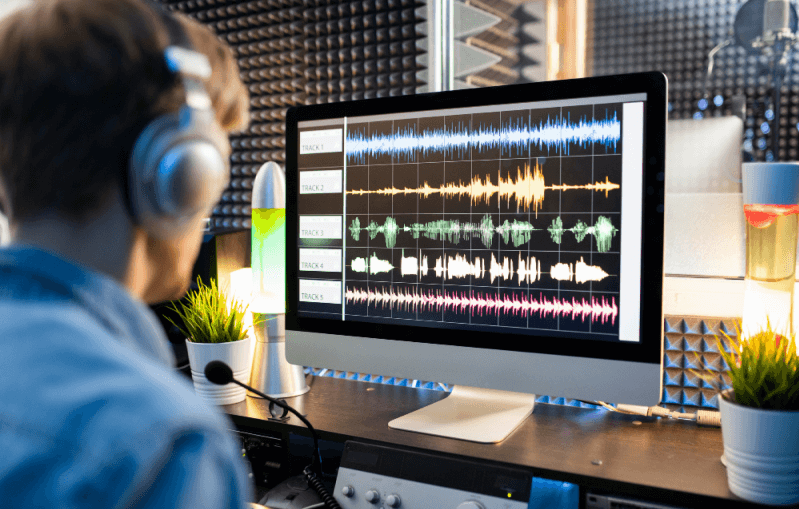How audio visual charlotte nc drives interaction with interactive technologies
Recognizing the Addition of Audio Visual Innovation in Today's Educational Environments
The integration of audio-visual modern technology in academic setups has changed the mentor and learning process. Educators currently have access to devices that provide to different finding out styles, boosting student involvement and collaboration. Nonetheless, the incorporation of these modern technologies presents both chances and challenges. Comprehending just how to effectively carry out these devices is vital. What approaches can educators utilize to make the most of the advantages of audio-visual modern technology in their classrooms?
The Development of Audio-Visual Modern Technology in Education And Learning
As educational requirements advanced over the decades, audio-visual innovation undertook significant changes that reshaped the discovering setting. Devices such as movie projectors and slide programs were the key means of integrating visual aspects right into class. These early technologies offered teachers with the capability to existing details dynamically, yet they were restricted in ease of access and interactivity.
With the arrival of videotape recorder in the 1970s, class started to include recorded lessons, broadening the range of academic sources. The intro of computers in the 1980s more changed this landscape, enabling the creation of multimedia presentations and interactive learning experiences.
The rise of the internet in the 1990s marked a turning point, enabling real-time access to a wide range of audio-visual products. Today, digital tools such as interactive whiteboards and online knowing platforms continue to enhance the instructional experience, cultivating interaction and partnership among students.
Benefits of Audio-Visual Tools for Diverse Learning Styles
Audio-visual devices play a crucial duty in accommodating diverse understanding designs by enhancing aesthetic discovering and enhancing auditory involvement. By integrating images, video clips, and sound, these modern technologies produce a more comprehensive academic setting. This diverse approach permits educators to resolve the different choices and requirements of students successfully.
Enhancing Visual Knowing
Involvement in the knowing procedure is substantially improved via the use of audio-visual devices, catering to different learning styles. These devices, such as videos, infographics, and interactive presentations, give visual stimulations that aid comprehension and retention. Aesthetic learners, specifically, gain from the consolidation of photos and animations, which can streamline complex ideas and enhance understanding. Furthermore, audio-visual resources can highlight real-world applications, making finding out more relevant and interesting. By integrating color, activity, and audio, teachers can develop a dynamic discovering atmosphere that captures pupils' interest and fosters much deeper cognitive connections. Inevitably, the calculated use of audio-visual innovation not just supports aesthetic learning yet additionally enriches the total educational experience for diverse learners.
Improving Auditory Involvement
A considerable benefit of integrating audio-visual devices in education and learning is their ability to improve acoustic engagement amongst students. These devices, which include multimedia discussions, podcasts, and interactive sound elements, cater to various learning styles, particularly benefiting auditory students (audio visual charlotte nc). By incorporating audio and narrative, instructors can develop immersive experiences that catch trainees' interest and strengthen comprehension. This engagement is vital, as it promotes a deeper understanding of the material and advertises retention. In addition, audio-visual devices can assist in collective discovering atmospheres, motivating students to join conversations and share their understandings. Eventually, the consolidation of audio-visual technology not only sustains auditory engagement but additionally improves the general educational experience, making finding out more vibrant and efficient for all trainees
Enhancing Engagement Via Interactive Discovering

Gamification elements, such as quizzes and simulations, can boost motivation and retention, making finding out much more enjoyable and efficient. These strategies not only promote cognitive involvement but additionally cater to diverse discovering styles, making sure that all pupils can participate meaningfully. Therefore, interactive discovering environments promote a feeling of area and belonging, inevitably resulting in boosted scholastic outcomes. Through the combination of audio visual innovation, instructors can change typical classrooms into vibrant spaces where trainees prosper and proactively form their academic trips.
Connecting Concept and Experiment Multimedia Resources
Multimedia sources act as a crucial link in between academic principles and sensible application in educational setups. By boosting involvement, facilitating collaborative learning experiences, and supporting varied understanding designs, these devices produce a much more inclusive and dynamic learning setting - audio visual charlotte nc. This strategy not just promotes deeper understanding but also prepares students for real-world obstacles

Enhancing Interaction Through Multimedia
Engagement in instructional settings significantly increases when teachers integrate multimedia resources right into their mentor methods. Using videos, podcasts, and interactive discussions improves the learning experience, permitting trainees to get in touch with the product on several degrees. Multimedia resources accommodate numerous learning designs, offering aesthetic, auditory, and kinesthetic stimulations that can hold trainees' attention better than traditional lecture techniques. Additionally, these sources can simplify complicated concepts, making them a lot more available and remarkable. By integrating multimedia, instructors can create a vibrant class atmosphere that cultivates curiosity and encourages learners. Eventually, the strategic usage of audio-visual technology serves to link the gap in between academic understanding and sensible application, enhancing the instructional experience for both instructors and trainees.
Promoting Collaborative Learning Experiences
Countless studies suggest that collective understanding experiences significantly boost student outcomes when incorporated with multimedia sources. Multimedia devices facilitate interaction among trainees, permitting them to participate in problem-solving and vital believing jointly. By using video clip conferencing, joint systems, and interactive discussions, educators create environments for team effort and shared discovering. These modern technologies make it possible for pupils to communicate their ideas effectively and receive immediate feedback, fostering a deeper understanding of the subject matter. Furthermore, multimedia resources can present complex concepts in more absorbable layouts, advertising conversation and cooperation. As an outcome, the mix of collective knowing and audio-visual innovation not only enriches the educational experience yet additionally prepares trainees for real-world team effort dynamics, emphasizing the importance of cooperation and cumulative understanding building.
Supporting Diverse Learning Styles
While typical training techniques typically accommodate a limited variety of discovering preferences, the integration of audio-visual modern technology uses a much look at this website more comprehensive technique to education. By employing multimedia sources such as videos, interactive simulations, and digital discussions, educators can resolve different learning designs, including aesthetic, auditory, and kinesthetic. This flexibility permits distinguished instruction, making it possible for students to involve with content in means that resonate with their specific preferences. In addition, audio-visual tools can facilitate much deeper understanding by providing multiple depictions of complex ideas. Consequently, students who may have problem with traditional techniques can find different pathways to success, cultivating a much more fair learning setting that sustains scholastic success for all students.
Challenges in Applying Audio-Visual Innovation
Audio-visual modern technology holds terrific promise for enhancing educational experiences, its execution usually encounters considerable difficulties. One key worry is the financial concern related anonymous to purchasing and keeping such devices, which can stress spending plans, especially in underfunded institutions. Additionally, insufficient training for educators can prevent reliable combination, leaving them ill-prepared to use the modern technology completely. Technical issues, such as software application malfunctions and compatibility problems, may also interfere with lessons and annoy both instructors and pupils. Moreover, differing levels of trainee access to technology outside the class can produce variations in discovering opportunities. Lastly, the capacity for over-reliance on innovation may interfere with vital teaching methods, inevitably restricting the academic experience. Dealing with these challenges needs a comprehensive technique, including adequate financing, professional development, and equitable accessibility to sources, to assure that audio-visual innovation can be leveraged efficiently in today's educational settings.
Best Practices for Integrating Modern Technology in the Classroom

In addition, cultivating an interactive environment through collaborative tools motivates trainee interaction and involvement. Using varied audio-visual sources accommodates various learning styles, accommodating visual, acoustic, and kinesthetic students. Routinely examining the effect of innovation on trainee discovering assists teachers refine their methods and adapt to altering needs. Finally, involving pupils in the option of modern technology advertises ownership and motivation. By sticking to these ideal techniques, teachers can create a dynamic class environment that efficiently integrates modern technology and boosts the academic experience for all trainees.
The Future of Audio-Visual Technology in Education And Learning
As class increasingly welcome innovation, the landscape of audio-visual tools in education and learning proceeds to develop (audio visual charlotte nc). Future advancements are expected to concentrate on greater interactivity and customization, allowing instructors to tailor learning experiences to private student demands. Developments such as augmented fact (AR) and online fact (VR) will likely provide immersive useful site discovering environments, boosting student involvement and understanding
Furthermore, artificial knowledge (AI) is positioned to play a considerable duty in audio-visual innovation by supplying real-time feedback and flexible understanding paths. This integration may assist instructors identify and attend to pupil challenges better. Cloud-based platforms will certainly facilitate simpler accessibility to sources and cooperation amongst pupils and instructors, despite location.
In addition to these technological breakthroughs, professional development for teachers will be vital, ensuring they are furnished to make use of these devices effectively. Overall, the future of audio-visual innovation in education guarantees to create more dynamic, inclusive, and impactful knowing experiences.
Often Asked Concerns
Exactly How Can Teachers Select the Right Audio-Visual Tools for Their Classrooms?
Selecting appropriate audio-visual tools requires teachers to assess their educational objectives, consider trainee needs, assess available technology, and seek recommendations from peers or specialists, making certain tools efficiently enhance learning and involvement within their details class atmosphere.
What Budget plan Considerations Are There for Executing Audio-Visual Innovation?
Budget factors to consider for applying audio-visual innovation include initial acquisition expenses, upkeep costs, training for personnel, and potential software program licensing charges. Additionally, long-term financial investment in updates and replacements should also be factored right into monetary planning.
Exist Particular Training Resources for Educators on Audio-Visual Equipment?
Numerous establishments offer training sources for instructors on audio-visual devices, including on-line programs, workshops, and instructional overviews. These resources intend to improve educators' abilities and confidence in properly integrating modern technology into their training methods.
How Do We Gauge the Effectiveness of Audio-Visual Modern Technology in Knowing?
Gauging the effectiveness of audio-visual modern technology in learning entails examining student interaction, understanding, retention rates, and general scholastic efficiency. Surveys, evaluations, and observational researches can provide useful understandings into its effect on instructional outcomes.
What Prevail Mistaken Beliefs About Audio-Visual Innovation in Education And Learning?
Usual misunderstandings regarding audio-visual modern technology in education include the idea that it guarantees engagement and discovering outcomes, along with the assumption that all students benefit similarly, forgeting individual knowing preferences and requirements.